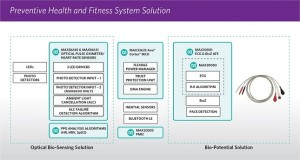Change is coming to ‘stagnant’ wearables market as heart rate sensors claim accurate monitoring

Today’s continuous monitoring tech is shifting the consumer mindset away from a reactive monitoring approach to a proactive one. And this is having a dramatic effect on the market for wearable technologies, as Jeremy Cowan reports.
Instead of waiting for annual visits to the doctor to get results for blood pressure and other vital signs, consumers want real-time information about their health status. So says Sui Shieh who is vice president, Industrial and Healthcare Business Unit at one wearables manufacturer, Maxim Integrated.
This shift is causing an increased demand for accurate, small, and low-power wearable devices, said to be an important enabler for this new way of thinking. As continuous monitoring and preventive healthcare become more common, both technology providers and health practitioners must embrace and accommodate these new demands to be successful, he believes.
“Global healthcare costs are high and growing,” says Sui, “with spend now running at 10% of gross domestic product (GDP) – in the US it’s $9 trillion (€7.64 trillion). The consumer mindset is moving from reeactive to proactive, with prevention and early detection (of illness) by fitness apps, and chronic disease monitoring” with healthcare devices. But, as he goes on to say, fitness apps generally give little information; that’s why the market has been stagnant for two years.
“The market is there,” he says, “with six million users in 2016 rising to 50 million in 2021, according to analysts, Berg Insight. Our customers are now looking for clinical-grade performance (with US Food & Drug Administration certification), the longest battery life, a small size, and high accuracy.”
Maxim believes that it’s now able to meet these requirements. Through compact, low power solutions, it has a new range of devices that enable accurate monitoring of vital signs to monitor wellness/fitness and prevent health problems before they even begin.
Maxim’s portfolio of sensors for wearable health and fitness applications allows consumers to accurately monitor a variety of key vital signs while being mindful of low power (for longer battery life) and small size (for convenience and comfort). The MAX86140 and MAX86141 can be used to measure PPG signals on the wrist, finger, and ear to detect heart rate, heart rate variability, and pulse oximetry.
The MAX30001 measures ECG and BioZ on the chest and wrist to detect heart rate, respiration, and arrhythmias. Compared to competitive solutions, the MAX86140 and MAX86141 is claimed to require less than half the power and is approximately one third smaller, while the MAX30001 requires approximately half the power in almost half the size. By collecting beat to beat data about the heart, these solutions collect accurate data so users can recognise important symptoms when they first begin. In addition, the MAX30001 meets IEC60601-2-47, clinical ECG standards.
“The convergence of clinical grade diagnostics in form factors small enough to integrate into all sorts of smart, everyday clothing is impressive,” said Adrian Straka, director of Hardware and Manufacturing, SKIIN. “The ultra-small MAX30001 enables SKIIN’s bio-sensing underwear to monitor and track health metrics 24 hours a day, 7 days a week in low power operation.”
Maxim Integrated Products, Inc.’s (NASDAQ: MXIM) preventive healthcare and continuous monitoring solutions for wearable health and fitness applications now include the MAX86140 and MAX86141 optical pulse oximeter/heart rate sensors, and the MAX30001 electrocardiogram (ECG) and bioimpedance (BioZ) analogue front end (AFE).
The MAX86140 and MAX86141 are supplied in a 20-pin WLP (2.048mm x 1.848mm) and operate over the-40-degree Celsius to +85-degree Celsius operating temperature range. The MAX30001 is supplied in a 28-pin TQFN and 30-bump WLP (2.7mm x 2.9mm). It operates over the 0-degree Celsius to 70-degree Celsius operating temperature range.
The author of this blog is Jeremy Cowan, editorial director & publisher of IoT Now
Comment on this article below or via Twitter @IoTGN


